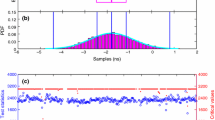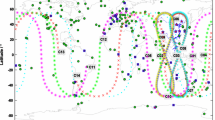Abstract
Care should be taken to minimize the adverse impact of differential code biases (DCBs) on global navigation satellite systems (GNSS)-derived ionospheric information determinations. For the sake of convenience, satellite and receiver DCB products provided by the International GNSS Service (IGS) are treated as constants over a period of 24 h (Li et al. (2014)). However, if DCB estimates show remarkable intra-day variability, the DCBs estimated as constants over 1-day period will partially account for ionospheric modeling error; in this case DCBs will be required to be estimated over shorter time period. Therefore, it is important to further gain insight into the short-term variation characteristics of receiver DCBs. In this contribution, the IGS combined global ionospheric maps and the German Aerospace Center (DLR)-provided satellite DCBs are used in the improved method to determine the multi-GNSS receiver DCBs with an hourly time resolution. The intra-day stability of the receiver DCBs is thereby analyzed in detail. Based on 1 month of data collected within the multi-GNSS experiment of the IGS, a good agreement within the receiver DCBs is found between the resulting receiver DCB estimates and multi-GNSS DCB products from the DLR at a level of 0.24 ns for GPS, 0.28 ns for GLONASS, 0.28 ns for BDS, and 0.30 ns for Galileo. Although most of the receiver DCBs are relatively stable over a 1-day period, large fluctuations (more than 9 ns between two consecutive hours) within the receiver DCBs can be found. We also demonstrate the impact of the significant short-term variations in receiver DCBs on the extraction of ionospheric total electron content (TEC), at a level of 12.96 TECu (TEC unit). Compared to daily receiver DCB estimates, the hourly DCB estimates obtained from this study can reflect the short-term variations of the DCB estimates more dedicatedly. The main conclusion is that preliminary analysis of characteristics of receiver DCB variations over short-term intervals should be finished prior to estimate daily multi-GNSS receiver DCB products.













Similar content being viewed by others
References
Abdelazeem M, Çelik RN, El-Rabbany A (2016) MGR-DCB: a precise model for multi-constellation GNSS receiver differential code bias. J Navig 69(04):698–708. https://doi.org/10.1017/s0373463315000922
Arikan F, Nayir H, Sezen U, Arikan O (2008) Estimation of single station interfrequency receiver bias using GPS-TEC. Radio Sci 43:RS4004. https://doi.org/10.1029/2007rs003785
Banville S, Langley RB (2011) Defining the basis of an integer-levelling procedure for estimating slant total electron content. In: Proceedings of the ION GNSS, pp 2542–2551
Brunini C, Azpilicueta FJ (2009) Accuracy assessment of the GPS-based slant total electron content. J Geod 83(8):773–785. https://doi.org/10.1007/s00190-008-0296-8
Ciraolo L, Azpilicueta F, Brunini C, Meza A, Radicella S (2007) Calibration errors on experimental slant total electron content (TEC) determined with GPS. J Geod 81(2):111–120
Coker C (1991) Variability of GPS satellite differential group delay biases. IEEE Trans Aerosp Electron Syst 27(6):931–938
Conte JF, Azpilicueta F, Brunini C (2011) Accuracy assessment of the GPS-TEC calibration constants by means of a simulation technique. J Geod 85(10):707–714. https://doi.org/10.1007/s00190-011-0477-8
Coster A, Williams J, Weatherwax A, Rideout W, Herne D (2013) Accuracy of GPS total electron content: GPS receiver bias temperature dependence. Radio Sci 48(2):190–196. https://doi.org/10.1002/rds.20011
Feltens J, Schaer S (1998) IGS products for the ionosphere. In: Proceedings of the 1998 IGS Analysis Center Workshop, Darmstadt
Hernández-Pajares M, Juan JM, Sanz J, Orus R, Garcia-Rigo A, Feltens J, Komjathy A, Schaer SC, Krankowski A (2009) The IGS VTEC maps: a reliable source of ionospheric information since 1998. J Geod 83(3–4):263–275. https://doi.org/10.1007/s00190-008-0266-1
Hernandez-Pajares M, Juan JM, Sanz J, Aragon-Angel A, Garcia-Rigo A, Salazar D, Escudero M (2011) The ionosphere: effects, GPS modeling and the benefits for space geodetic techniques. J Geod 85(12):887–907. https://doi.org/10.1007/s00190-011-0508-5
Kao S, Tu Y, Chen W, Weng D, Ji S (2013) Factors affecting the estimation of GPS receiver instrumental biases. Surv Rev 45(328):59–67
Keshin M (2012) A new algorithm for single receiver DCB estimation using IGS TEC maps. GPS Solut 16(3):283–292
Komjathy A (1997) Global ionospheric total electron content mapping using the Global Positioning System. Ph.D. dissertation, Department of Geodesy and Geomatics Engineering Technical Report NO. 188, University of New Brunswick, Fredericton, New Brunswick, Canada, 248 pp
Komjathy A, Sparks L, Wilson BD, Mannucci AJ (2005) Automated daily processing of more than 1000 ground-based GPS receivers for studying intense ionospheric storms. Radio Sci 40:RS6006. https://doi.org/10.1029/2005rs003279
Krankowski A, Kosek W, Baran L, Popinski W (2005) Wavelet analysis and forecasting of VTEC obtained with GPS observations over European latitudes. J Atmos Sol-Terr Phys 67(12):1147–1156
Lanyi GE, Roth T (1988) A comparison of mapped and measured total ionospheric electron content using global positioning system and beacon satellite observations. Radio Sci 23(4):483–492
Li Z, Yuan Y, Li H, Ou J, Huo X (2012) Two-step method for the determination of the differential code biases of COMPASS satellites. J Geod 86(11):1059–1076. https://doi.org/10.1007/s00190-012-0565-4
Li Z, Yuan Y, Fan L, Huo X, Hsu H (2014) Determination of the differential code bias for current BDS satellites. IEEE Trans Geosci Remote Sens 52(7):3968–3979. https://doi.org/10.1109/tgrs.2013.2278545
Li M, Yuan Y, Wang N, Li Z, Li Y, Huo X (2017) Estimation and analysis of Galileo differential code biases. J Geod 91(3):279–293. https://doi.org/10.1007/s00190-016-0962-1
Mannucci AJ, Wilson BD, Yuan DN, Ho CH, Lindqwister UJ, Runge TF (1998) A global mapping technique for GPS-derived ionospheric total electron content measurements. Radio Sci 33(3):565–582. https://doi.org/10.1029/97rs02707
Mayer C, Becker C, Jakowski N, Meurer M (2011) Ionosphere monitoring and inter-frequency bias determination using Galileo: first results and future prospects. Adv Space Res 47(5):859–866
Montenbruck O, Hauschild A, Steigenberger P (2014) Differential code bias estimation using multi-GNSS observations and global ionosphere maps. In: Proceedings of the 2014 international technical meeting of the Institute of Navigation, pp 802–812
Odijk D, Nadarajah N, Zaminpardaz S, Teunissen PJG (2016) GPS, Galileo, QZSS and IRNSS differential ISBs: estimation and application. GPS Solut. https://doi.org/10.1007/s10291-016-0536-y
Rao GS (2007) GPS satellite and receiver instrumental biases estimation using least squares method for accurate ionosphere modelling. J Earth Syst Sci 116(5):407–411
Sardón E, Zarraoa N (1997) Estimation of total electron content using GPS data: How stable are the differential satellite and receiver instrumental biases? Radio Sci 32(5):1899–1910
Schaer S (1999) Mapping and predicting the Earth’s ionosphere using the Global Positioning System. Ph.D. Dissertation Astronomical Institute, University of Berne, Berne, Switzerland, 25 March 1999
Shi C, Gu S, Lou Y, Ge M (2012) An improved approach to model ionospheric delays for single-frequency precise point positioning. Adv Space Res 49(12):1698–1708
Wang N, Yuan Y, Li Z, Montenbruck O, Tan B (2016) Determination of differential code biases with multi-GNSS observations. J Geod 90(3):209–228
Warnant R (1997) Reliability of the TEC computed using GPS measurements—the problem of hardware biases. Acta Geod Geophys Hung 32(3–4):451–459
Wilson B, Mannucci AJ (1993) Instrumental biases in ionospheric measurements derived from GPS data. In: Proceedings of the Institute of Navigation GPS-93, pp 1343–1351
Xue J, Song S, Zhu W (2016) Estimation of differential code biases for Beidou navigation system using multi-GNSS observations: How stable are the differential satellite and receiver code biases? J Geod 90(4):309–321
Yuan YB, Ou JK (1999) The effects of instrumental bias in GPS observations on determining ionospheric delays and the methods of its calibration. Acta Geod Cartogr Sin 38:110–114
Yuan YB, Ou JK (2004) A generalized trigonometric series function model for determining ionospheric delay. Prog Nat Sci 14(11):1010–1014. https://doi.org/10.1080/10020070412331344711
Yuan YB, Huo XL, Ou JK (2007) Models and methods for precise determination of ionospheric delay using GPS. Prog Nat Sci 17(2):187–196
Yuan YB, Li ZS, Wang NB, Zhang BC, Li H, Li M, Huo XL, Ou JK (2015) Monitoring the ionosphere based on the Crustal Movement Observation Network of China. Geod Geodyn 6(2):73–80. https://doi.org/10.1016/j.geog.2015.01.004
Zhang BC, Teunissen PJ (2015) Characterization of multi-GNSS between-receiver differential code biases using zero and short baselines. Sci Bull 60(21):1840–1849
Zhang B, Teunissen PJ (2016) Zero-baseline analysis of GPS/BeiDou/Galileo between-receiver differential code biases (BR-DCBs): time-wise retrieval and preliminary characterization. Navigation 63(2):181–191
Zhang DH, Shi H, Jin YQ, Zhang W, Hao YQ, Xiao Z (2013) The variation of the estimated GPS instrumental bias and its possible connection with ionospheric variability. Sci China Technol Sci 57(1):67–79. https://doi.org/10.1007/s11431-013-5419-7
Zhang B, Yuan Y, Ou J (2016a) Short-term temporal variability of GPS receiver’s differential code biases (DCB): retrieving and modeling. Chin J Geophys 59(1):101–115
Zhang B, Teunissen PJG, Yuan Y (2016b) On the short-term temporal variations of GNSS receiver differential phase biases. J Geod. https://doi.org/10.1007/s00190-016-0983-9
Zhang B, Teunissen PJ, Yuan Y, Zhang H, Li M (2017) Joint estimation of vertical total electron content (VTEC) and satellite differential code biases (SDCBs) using low-cost receivers. J Geod 2017:1–13. https://doi.org/10.1007/s00190-017-1071-5
Acknowledgements
This work is supported by the National key Research Program of China “Collaborative Precision Positioning Project” (No. 2016YFB0501900), China Natural Science Funds (Nos. 41231064, 41674022, 41604031). Many thanks go to the IGS MGEX and DLR for providing access to multi-GNSS data and DCB as well as ionospheric GIM products.
Author information
Authors and Affiliations
Corresponding authors
Rights and permissions
About this article
Cite this article
Li, M., Yuan, Y., Wang, N. et al. Estimation and analysis of the short-term variations of multi-GNSS receiver differential code biases using global ionosphere maps. J Geod 92, 889–903 (2018). https://doi.org/10.1007/s00190-017-1101-3
Received:
Accepted:
Published:
Issue Date:
DOI: https://doi.org/10.1007/s00190-017-1101-3




